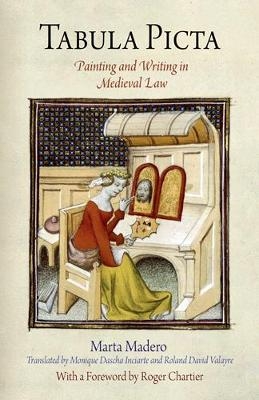
Tabula Picta
Painting and Writing in Medieval Law
Seiten
2009
University of Pennsylvania Press (Verlag)
978-0-8122-4186-0 (ISBN)
University of Pennsylvania Press (Verlag)
978-0-8122-4186-0 (ISBN)
- Lieferbar (Termin unbekannt)
- Versandkostenfrei innerhalb Deutschlands
- Auch auf Rechnung
- Verfügbarkeit in der Filiale vor Ort prüfen
- Artikel merken
Who owns the tabula picta, the painted tablet? The owner of the tablet? Or to the person who painted it? This meticulous analysis of how medieval jurists responded to these questions is a major a contribution to the history of the proprietary rights to artistic works and to the history of ideas.
To whom does a painted tablet—a tabula picta—belong? To the owner of the physical piece of wood on which an image is painted? Or to the person who made the painting on that piece of wood? By extension, one might ask, who is the owner of a text? Is it the person who has written the words, or the individual who possesses the piece of parchment or slab of stone on which those words are inscribed?
In Tabula Picta Marta Madero turns to the extensive glosses and commentaries that medieval jurists dedicated to the above questions when articulating a notion of intellectual and artistic property radically different from our own. The most important goal for these legal thinkers, Madero argues, was to situate things—whatever they might be—within a logical framework that would allow for their description, categorization, and placement within a proper hierarchical order. Only juridical reasoning, they claimed, was capable of sorting out the individual elements that nature or human art had brought together in a single unit; by establishing sets of distinctions and taxonomies worthy of Borges, legal discourse sought to demonstrate that behind the deceptive immediacy of things, lie the concepts and arguments of what one might call the artifices of the concrete.
To whom does a painted tablet—a tabula picta—belong? To the owner of the physical piece of wood on which an image is painted? Or to the person who made the painting on that piece of wood? By extension, one might ask, who is the owner of a text? Is it the person who has written the words, or the individual who possesses the piece of parchment or slab of stone on which those words are inscribed?
In Tabula Picta Marta Madero turns to the extensive glosses and commentaries that medieval jurists dedicated to the above questions when articulating a notion of intellectual and artistic property radically different from our own. The most important goal for these legal thinkers, Madero argues, was to situate things—whatever they might be—within a logical framework that would allow for their description, categorization, and placement within a proper hierarchical order. Only juridical reasoning, they claimed, was capable of sorting out the individual elements that nature or human art had brought together in a single unit; by establishing sets of distinctions and taxonomies worthy of Borges, legal discourse sought to demonstrate that behind the deceptive immediacy of things, lie the concepts and arguments of what one might call the artifices of the concrete.
Marta Madero is Professor of Medieval History at Universidad Nacional de Gerneral Sarmiento in Argentina.
Foreword
Introduction
1. Dominium and Object Extinction
2. Accessio
3. Specificatio
4. Form, Being, and Name
5. Ferruminatio, Adplumbatio
6. Factae and Infectae
7. Praevalentia
8. Pretium and Pretiositas
9. The Part and the Whole
10. Ornandi Causa
11. Qualitas and Substantia
Conclusion
Appendixes
Notes
Bibliography
Index
Acknowledgments
| Erscheint lt. Verlag | 16.10.2009 |
|---|---|
| Reihe/Serie | Material Texts |
| Co-Autor | Roger Chartier |
| Übersetzer | Monique Dascha Inciarte, Roland David Valayre |
| Verlagsort | Pennsylvania |
| Sprache | englisch |
| Maße | 152 x 229 mm |
| Themenwelt | Geschichte ► Allgemeine Geschichte ► Mittelalter |
| ISBN-10 | 0-8122-4186-X / 081224186X |
| ISBN-13 | 978-0-8122-4186-0 / 9780812241860 |
| Zustand | Neuware |
| Haben Sie eine Frage zum Produkt? |
Mehr entdecken
aus dem Bereich
aus dem Bereich
eine neue Geschichte des Mittelalters
Buch | Hardcover (2023)
C.H.Beck (Verlag)
38,00 €


